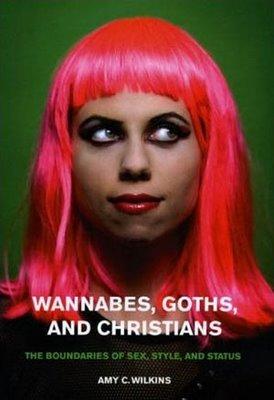Wannabes, Goths, and Christians: The Boundaries of Sex, Style, and Status

Labels—freak, geek, wigger, poser, prep, to name just a few—are plentiful and ever-expanding, flourishing in the fertile social grounds of high school and college. Often, labels are used against individuals, assigned and branded as tools of marginalization and preservation of social hierarchies. Amy C. Wilkins' Wannabes, Goths, and Christians: The Boundaries of Sex, Style, and Status is a sociological text that explores the ways labels can rather be symbols of resistance, or attempted empowerment, for three distinct subcultures coexisting in an insulated but diverse cross-section of a Northeastern college region.
Wannabes, Goths, and Christians is about the ways in which three groups of young adults in the United States test, push, and break the boundaries of an identity that paradoxically remains largely invisible, yet overwhelmingly dominant: "Whiteness." The self-described “freaks” of Goth, the members of a Christian organization at a large university, and the Puerto Rican "wannabes" are each given their due in a book that creates connections between seemingly disparate groups. Even those readers who are not sociologists by study or trade will appreciate the candor and perception with which Wilkins writes about the subjects of the book, as well as her forward-thinking analysis surrounding the important, but often overlooked, intersections of race, class, and gender within these predominantly white communities.
To write it, Wilkins engaged in countless interviews; some were formally conducted and others were casual conversations, not only with the subjects themselves, but also with their more mainstream peers, whose reactions and opinions spoke volumes about the way the strategic separation from the norm of Goths, Christians and wannabes elicits often volatile emotions from those who wish they would "act like what they are."
As much as possible, Wilkins tried to assimilate into these countercultures, whether by sexing up her appearance in black lace and dramatic Goth makeup, or by gelling her hair back and drawing on dark lip-liner to achieve the stereotypically Puerto Rican look of the wannabe. With her transformations complete, she would hit specifically geared club nights with her new tutors, subjects who had agreed, sometimes hesitantly, to take her under their wings and show her the ropes. Unexpectedly, the group that, of the three, prides itself most on kindness and goodwill was the hardest group to penetrate; Wilkins writes that although the University Unity Christians allowed her to attend meetings and agreed to speak with her in interviews, they were reserved, hesitant to open up, and never fully accepted her as an insider.
Wilkins effectively digs to the core of how subcultures are formed and fostered, particularly among young, white, middle-class people. In the United States, where society at large collectively fails to acknowledge the way white youth experience a broad spectrum of race, class, and gender, "whiteness" amounts to a lack of culture, in an environment that equates culture with "cool." In unique ways, the subjects of Wannabes, Goths, and Christians are eschewing what they see as a bland and narrow path of lack, in favor of a performed, chosen identity that may open up new alternatives to the umbrella of white identity. Wilkins insightful, fresh, sociologically focused portraits are much more than character studies, and the text is much more than tired "don’t judge a book by its cover" platitudes about today’s youth.
That's really interesting. I think this area of research is fascinating and much work remains to be done.
The author's methodology is brave and engaging for us to read about--I imagine, since I haven't read the book.
Intriguing subject matter, and it seems the author approached it from an analytical yet empathic manner.
I'm sold.
This sounds like a great read. Makes me think back to undergrad, when this mostly white group of Christian kids wore these t-shirts non-stop for about a month. I don't remember their cause or message; I only remember how disturbed everyone else was by this supposedly unhygienic stand for/against...whatever it was.